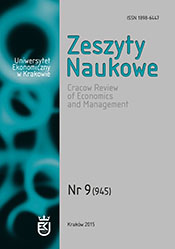Relacje przyczynowo-skutkowe pomiędzy czynnikami produkcji a wzrostem gospodarczym w Polsce w latach 1992–2012 z uwzględnieniem roli bezpośrednich inwestycji zagranicznych
Cause-and-Effect Relationships between Factors of Production and Economic Growth in Poland in the Years 1992–2012, Including the Role of Foreign Direct Investment
Author(s): Aneta KosztowniakSubject(s): Economy
Published by: Wydawnictwo Uniwersytetu Ekonomicznego w Krakowie
Keywords: cause-and-effect relationships; GDP; factors of production; FDI; VECM
Summary/Abstract: The aim of this paper is to analyse and assess the cause-and-effect relationships occurring between the main factors of production and GDP in Poland in the years 1992–2012, including the significance of FDI, with the use of the vector error correction model (VECM), impulse response functions and variance decomposition for random variables to identify the key instruments stimulating short-, medium- and long-term economic growth. As far as theoretical analysis is concerned, the paper offers a review of the international and Polish literature on the topic of relationships between FDI and economic growth and the results of research into cause-and-effect relationships occurring between them. Empirical analysis was conducted on the basis of the OECD and UNCTAD statistical data for the years 1992–2012, with the use of econometric methods, including: the VAR model and its conversion in the form of VECM, analysis of impulse response functions and variance decomposition of random variables.The following research hypothesis was adopted: complicated cause-and-effect relationships occur between the factors of production and GDP in Poland in the short-, medium- and long-term. Results of sensitivity analysis of coefficients of variation and analysis of the degree of explaining variables confirm the need to use a diversified set of factors of production to maximize economic growth in Poland, adequately to the period of their strongest impact.The key factors of short-term economic growth in Poland are: gross fixed capital formation, exports and FDI; in the medium-term: gross fixed capital formation, FDI, and R&D; and in the long-term: gross fixed capital formation, employment, FDI and R&D. What is more, a growing GDP value attracts FDI inflows more strongly while FDI inflows have a smaller impact on GDP growth stimulation. This fact can be explained by, among other things, the structure of FDI flowing into Poland, i.e. a decreasing value of the country’s own capital as compared to the growing share of credit and debt securities.
Journal: Zeszyty Naukowe Uniwersytetu Ekonomicznego w Krakowie
- Issue Year: 945/2015
- Issue No: 09
- Page Range: 99-123
- Page Count: 25
- Language: Polish

